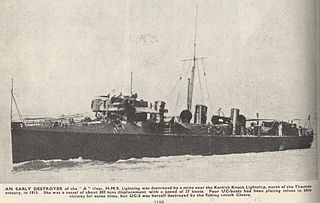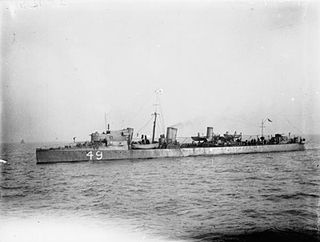Construction
HMS Zebra was ordered on 7 February 1894 from Thames Iron Works, Blackwall, London as part of the British Admiralty's 1893–1894 shipbuilding programme, one of 36 "Twenty-seven Knotter" destroyers ordered from 14 different shipbuilders for this programme. [4] [1]
These destroyers were not of a standard design, with the Admiralty laying down broad requirements, including a trial speed of 27 knots (31 mph; 50 km/h), a "turtleback" forecastle and a standard armament of a QF 12 pounder 12 cwt (3 in (76 mm) calibre) gun on a platform on the ship's conning tower (in practice the platform was also used as the ship's bridge), with a secondary armament of five 6-pounder guns, and two 18-inch (450 mm) torpedo tubes. [5] [6] [7] Thames Iron Work's design had three funnels, with the forward funnel widely separated from the other two, with one of the two torpedo tubes positioned in this gap. Three White water-tube boilers fed four-cylinder reciprocating steam engines rated at 4,800 ihp (3,600 kW) and driving two shafts. [1] [8]
Zebra was laid down on 1 July 1894 and launched on 13 December 1895. Thames Iron Works was relatively inexperienced in building torpedo craft (it had previously built the hull of a single torpedo boat as a subcontractor for Maudslay, Sons and Field (who supplied the engines for Zebra) and it took a long time for the ship to be completed and to complete trials (where she eventually reached the contract speed of 27 knots [2] ), not being accepted by the Navy until January 1900. [1]
Zebra was not particularly successful in service and no further orders for destroyers were placed with Thames Iron Works for many years. [1]
Operational history
HMS Zebra served in British home waters for the whole of her career. [1] In January 1900 she was employed as tender to the Wildfire, special service vessel, for training duties in connection with Sheerness Naval School of Gunnery. [9] On 17 October 1900, Zebra collided with the barge Emily off Sheerness, sinking the barge and damaging the destroyer's bow. Zebra rescued the barge's crew. [10] The following year she participated in the 1901 British Naval Manoeuvres. [11] In March 1902 Lieutenant James W. G. Innes was appointed in command, [12] but the appointment was cancelled and Lieutenant Wyndham L. Bamber was appointed in command the following month. [13] She served in the Portsmouth Instructional flotilla in May 1902, [14] and took part in the fleet review held at Spithead on 16 August 1902 for the coronation of King Edward VII. [15]
Zebra formed part of the 6th Destroyer Flotilla in 1910, and in 1912. [16] On 14 June 1911 the destroyer Zephyr collided with Zebra during night exercises off the mouth of the River Thames. One of Zebra's six-pounder guns and two of her boats were knocked into the sea, but no crew were injured. [17] After repair, Zebra was attached to the submarine flotilla based at Dundee, relieving the destroyer Teazer. [18]
On 30 August 1912 the Admiralty directed all destroyers were to be grouped into classes designated by letters based on contract speed and appearance. Like all the surviving Twenty-six and Twenty-seven Knotters, Zebra was assigned to the A Class. [19] [20] The class letters were painted on the hull below the bridge area and on a funnel. [21]
By March 1913, Zebra was laid up at Sheerness and listed for sale. [22] Zebra was sold for scrapping on 30 July 1914. [1]
HMS Kangaroo was a B-class torpedo boat destroyer of the British Royal Navy. She served with the Dover Patrol in the First World War.
HMS Seal was a B-class torpedo boat destroyer of the British Royal Navy. She was completed by Laird, Son & Company, Birkenhead, in 1897.
HMS Panther was a B-class torpedo boat destroyer of the British Royal Navy. She was completed by Laird, Son & Company, Birkenhead, in 1897.
HMS Locust was a B-class torpedo boat destroyer of the British Royal Navy. She was launched by Laird, Son & Company, Birkenhead, on 5 December 1896. She served in the Mediterranean between 1902 and 1906, and was used for patrol and escort duties during the First World War
HMS Sprightly was a B-class torpedo boat destroyer of the British Royal Navy. She was built speculatively by Laird, Son & Company, Birkenhead, pre-empting further orders for vessels of this type, and was purchased by the navy in 1901.

HMS Charger was a Charger-class destroyer which served with the Royal Navy. She was launched by Yarrow Shipbuilders at Poplar, London on 15 September 1894, served in home waters and was sold off in 1912.

HMS Dasher was a Charger-class destroyer which served with the Royal Navy. She was built by Yarrow Shipbuilders in 1895, served in home waters and was sold in 1911.
HMS Haughty was a Hardy-class destroyer which served with the Royal Navy. She was launched by William Doxford & Sons on 18 September 1895, served in home waters, and was sold on 10 April 1912.

HMS Lightning was a Janus-class destroyer of the British Royal Navy, later designated an A-class destroyer, built by Palmers and launched in 1895.
HMS Porcupine was a Janus-class destroyer of the Royal Navy. She was launched by Palmers Shipbuilding and Iron Company in 1895, served in home waters and was in service during the First World War.
HMS Fervent was a Fervent-class destroyer which served with the Royal Navy. Fervent was launched on 28 March 1895 at Paisley.

HMS Zephyr was one of two Fervent-class destroyers which served with the Royal Navy. She was launched on 10 May 1895 from Hanna, Donald & Wilson at Paisley, Scotland. She served in home waters, and was sold in 1920.

HMS Wizard was a Conflict-class destroyer built by the White shipyard for the Royal Navy, and launched on 26 February 1895. In 1910, she was reconstructed with only two funnels. She is believed to be the only destroyer fitted with in turning screws. She was sold in 1920.

HMS Sturgeon was the lead ship of the Sturgeon-class destroyers which served with the Royal Navy. Built by Vickers, she was launched in 1894 and sold in 1910.
HMS Peterel was one of two Spiteful-class destroyers to serve with the Royal Navy. She was built by Palmers, was 215 feet long and the 6,200 H.P. produced by her Reed boilers gave her a top speed of 30 knots. She was armed, as was standard, with a twelve pounder and two torpedo tubes. She served in home waters throughout the Great War and was sold off in 1919.
HMS Myrmidon was one of two Myrmidon-class destroyers which served with the Royal Navy.
HMS Star was a Palmer three-funnel, 30-knot destroyer ordered by the Royal Navy under the 1896–1897 Naval Estimates. She was the eleventh ship to carry this name since it was introduced in 1643 for a 19-gun ship sold until 1652.

HMS Dove was a three funnel, 30 knot destroyer ordered by the Royal Navy under the 1896–1897 Naval Estimates. She was the ninth ship to carry the name.

HMS Recruit was a Clydebank three-funnel, 30-knot destroyer ordered by the Royal Navy under the 1895–1896 Naval Estimates. She was the fifth ship to carry this name since it was introduced in 1806 for an 18-gun brig-sloop, sold in 1822.

HMS Kestrel was a Clydebank-built three funnelled 30-knot destroyer ordered by the Royal Navy under the 1895 – 1896 Naval Estimates. She was the fourth ship to carry this name since it was first used in 1846 for a brigantine.
This page is based on this
Wikipedia article Text is available under the
CC BY-SA 4.0 license; additional terms may apply.
Images, videos and audio are available under their respective licenses.








